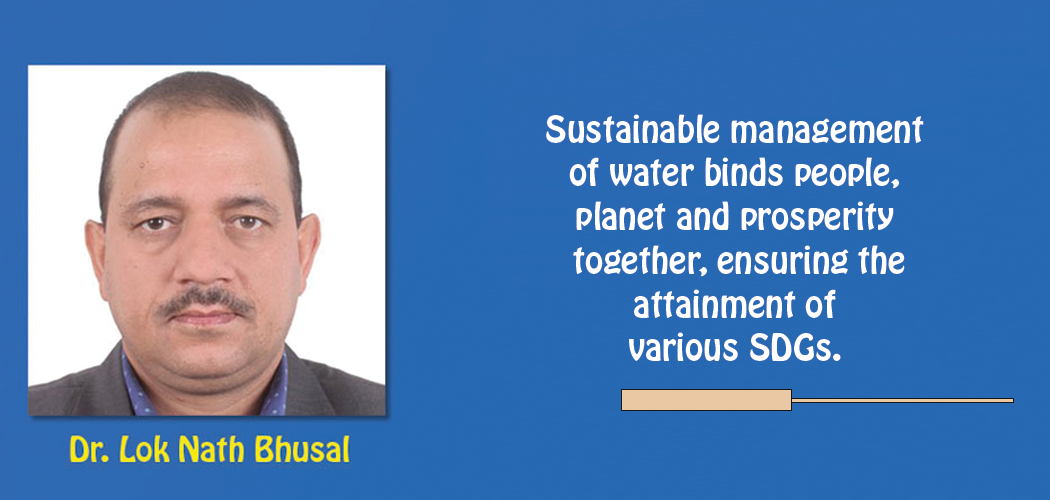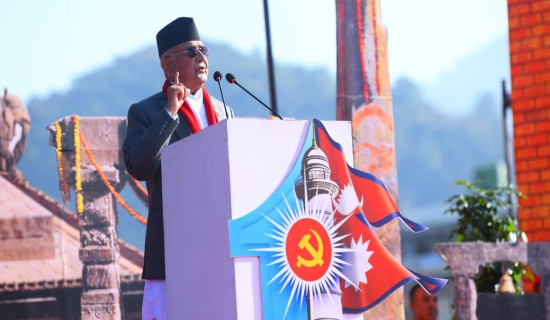- Saturday, 13 December 2025
Water Management For Sustainable Development
Dr. Lok Nath Bhusal
Life is impossible without water. In the form of rainfall, surface or ground, water feeds plants and humans; protects environment and biodiversity; provides crucial hydro energy. Water cleans and lightens our surroundings. Water serves us in multiple ways. It can also be argued that without water, Sustainable Development Goals (SDGs) cannot be realised. For ages, Hindus have not only worshipped water as Jaldewata, but they also adored all the sources of water and Indradev for timely rainfall to prevent drought and crop failures.
Access to water and sanitation for all (Goal 6 of SDGs), contributes to achieving most goals. Poverty and hunger will increase if there is no access to drinking water and irrigation facility. Health and education targets will face the same fortune. Agricultural and industrial development is not possible without water. Similarly, smart cities, clean environment, biodiversity, clean energy, economic growth, climate adaptation, disaster reduction and other SDGs cannot be realised without water. Therefore, the success of SDGs critically hinges on the access and proper utilisation of water.
Economic growth
World Bank has stated that water “drives economic growth, supports healthy ecosystems, and is essential and fundamental for life itself.” Due to such importance, water has invited conflicts in different parts of the world. Billions of people face water shortage around the globe. It is obvious that this situation leaves large section of the populations vulnerable to water-related illnesses. Insufficient or polluted water costs human lives and other crucial economic losses. It has been estimated that in Ghana “the cost of environmental degradation due to water pollution is equivalent to three per cent of GDP.”
COVID-19 has also proved the importance of water for preventing the pandemic; water makes it possible to wash our hands frequently. It is said that “appreciating the true value of water will prompt us to take action to protect this vital resource for the benefit of all.” Availability of water, as a common resource, is falling over time and water crisis is the fifth highest risk to society according to the 2020 edition of the World Economic Forum’s Global Risks report. It is obvious that climate change will significantly affect water resource availability globally. In Nepal too, spring water has stopped coming in various places, including in Matatirtha of Kathmandu.
Valuing the multiple uses of water, from agriculture to power generation, transport, industry, domestic use, ecosystems, fisheries, and livelihoods will help transform the climate crisis into an opportunity for advancing sustainable development. Following three strategies must be pursued to derive benefits from water resource. First, a strategy of increased momentum for integrated water resources governance and planning is required. There is increasing recognition of the power of better planning and integrated governance of water resources to enhance climate resilience. It is said that good planning is equal to half doing. Effective regulatory frameworks and tools for managing and protecting water resources are helping to improve water security around the globe.
Public awareness and education in water resource management must be conducted as a priority intervention. Transboundary and international cooperation in the management of shared water resources is also an urgent task before the international community. China, Nepal and India can work together in this area. These actions will help achieving various targets of the SDGs. Second, ambitious climate plans are required as these present opportunities for better utilisation of water resource. Countries need to update and increase their Nationally Determined Contribution (NDC) as part of their commitments under the Paris Agreement on Climate Change.
This must ensure clean drinking water, efficient irrigation and drainage systems, basin management, wastewater recycling and reuse, and rainwater harvesting across the globe. Traditional energy sources must be replaced by modern clean energy sources. This will also ensure a more inclusive, resilient and low carbon development. A transition to renewable energy, such as solar power, will reduce the stress on available water resources in the face of a changing climate. It is clear that renewable energy resources will contribute to less emission of pollutants in the environment.
Gender equality
Third, there is an urgent need to ensure gender equality and pro-poorness in water resources management. This is actually a smart investment. Addressing the differentiated impact of climate change on people opens up new opportunities to free up time for more productive use. It is true that, globally, women are more exposed to water whether it is collecting water or using it for various purposes, such as cooking and cleaning. Research shows that investments in water infrastructure can reduce burdens on women and girls. This equally applies for the poor. Hence, better water management is also better inclusive and equitable development.
Gaps in access to water supply have become “one of the greatest risks to economic progress, poverty eradication and sustainable development” notes the World Bank. Recognising this, International Water Management Institute (IWMI) has prioritised poverty reduction and inclusive development in its 2019-2023 strategy. Sustainable management of water binds people, planet and prosperity together, ensuring the attainment of various SDGs. We need increased investments in water infrastructure such as drinking water, sanitation, irrigation and clean energy generation by all the three tires of government. It is good that Nepal, in addition to increasing access to drinking water and irrigation facilities over the years, has recently started to earn money by selling hydropower to India.
(Dr. Bhusal works at the National Planning Commission. These are his personal views.)














